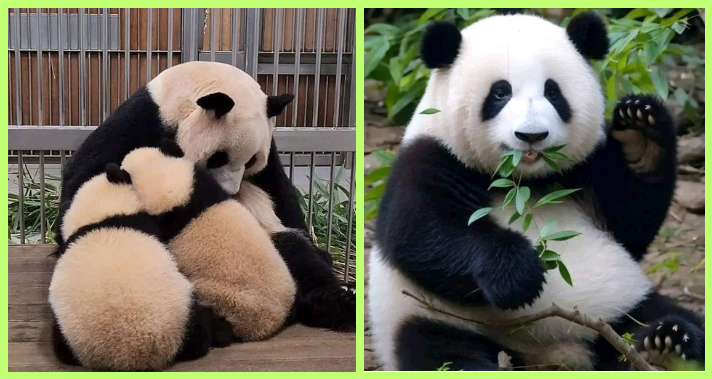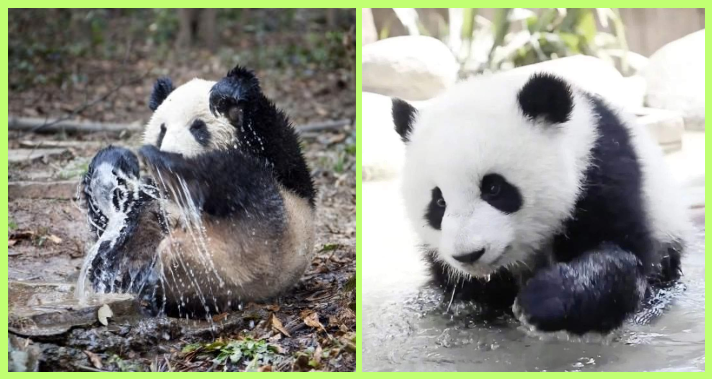High up in the clouds in the mountains of China, where the air is cool and the nights are freezing, live the gentle and quiet pandas. These peaceful animals spend their lives among the bamboo forests that extend on steep slopes and hidden valleys. During the day, air can be mild yet when the sun goes down, temperatures go down quickly. Cold winds blow through the forest and the ground is humming with condensation and ice. Yet, the pandas are able to survive here with no fear of the cold. They are perfectly adapted to living in this cold environment in their bodies and habits. This blog discusses the way that the panda deals with the cold nights it experiences in the high mountain region and what to the panda keeps them warm and comfortable even when the world around them is freezing cold.
How Pandas Handle the Cold Nights
Pandas live in the mountain where the weather is changing so quickly. In summer, the forests are so full of mist and gentle rain. In winter, leaves are covered by frost and the ground is covered by snow. These mountains are thousands of meters above sea level, where the air is thin of oxygen and it is crisp. The nights are most difficult, with temperatures cool and cold to such a point that water freezes. Despite this, panda do not migrate to somewhere allow and does not hibernate, like some other animals. They stay all year round in the mountains, standing insensitive to the cold with morose energy.
One of the important factors as to why pandas can survive cold nights is their thick fur. Panda fur is not only beautiful, but extremely useful, as well. It grows in two layers. The inner layer is thick and soft in nature, retaining warm air close to the skin. The outside layer is longer and rougher, keeping the rain, snow and wind away. The black and white colors of their fur also helps in a small way. The black portions absorb heat during the day and the white fur blends into the snow and helps to reflect the sun’s rays. This balance helps them to maintain their body temperature during the day and the night.
#1. Mother panda loves a lot her baby pandas

#2. Panda tries to fit between the trees

When the air gets colder, the fur contains a greater amount of heat. It acts like a warm blanket that will never leave their body. This natural insulation is sufficient to keep the pandas from freezing winds even at high altitudes. Even though the pandas eat mostly bamboo which is very low in fat content, they still hold small amounts of fat in their body. This fat serves as a buffer to provide energy when it is cold at night. When temperatures drop, their body burns such fat on a slow burn to produce heat. The fat under their skin also helps to insulate them like a form of protection. It limits the loss of body warmth through the skin as well as providing them with extra protection against the chill of snow-covered ground.
#3. Baby panda eats fresh bamboo leaves

#4. Baby panda looking at mother panda

Pandas know how to choose their sleeping place in the forest, as they know the forest well. When night arrives, they do not rest in open areas where they are subject to cold winds. Instead, they take shelter in natural habitats such as rock caves, hollow tree trunks or in dense groves of bamboo plants. These spots prevent the wind and keep out snow. The thick plants or rocks surrounding them function like natural walls and trap the warm air inside. The ground under these shelters tends to remain a bit warmer because it is littered with dry leaves and bamboo sticks. Sometimes, panda makes shallow nests in bamboo forest using dry plants. These little repose places are soft, quiet and protected.
#5. Pandas love to roll down

By selecting such spots they limit the amount of heat their body loses during long cold nights. In the very cold night, panda rests by curling its body to a round shape. This position helps with keeping the warmth in. They pull their head under their arms and take their legs to the body. By minimizing the surface area landmarked, they maintain more heat in their fur. Their breathing also slows down in rest and energy is saved. They sleep soundly and quietly until the morning sun comes and warms the forest one more time.
#6. This is how newly born panda looks like

Another way that pandas deal with the cold is by moving around in the day. Even though they move slowly, because of the constant activity, it keeps their body warm. They have to spend a majority of the time eating bamboo, which takes effort and energy. Chewing, walking and climbing through the forest generates body heat. By being active during the day, panda’s have built up warmth which lasts part of the night. They also use rays from the sun to warm their fur, hence they are often seen sitting at open places in calm afternoons and they retreat to seek shelter later.
#7. Panda parcel

The high mountains have thin air which means less oxygen. But pandas have adapted to be content with the air in this environment. Their lungs are big and efficient and it helps them use oxygen more. This helps their body to continue to produce heat even when the air is cold and light. Their slow lifestyle is also a help. Since they are moving in a calm manner, their body does not lose too much energy. This means that the warmth they create lasts for longer. Pandas also drink water from nearby streams that are in liquid form even during winter because of continuous flow in streams. Hydration helps their body to maintain a healthy temperature and also it helps in keeping their system balanced during long cold nights.
#8. They are sitting on the plane

When the weather gets too cold in the high mountains pandas move sometime down to low places. These lower slopes are warmer and are less covered with snow. The bamboo there remains green; it is easier to find. It is this small seasonal movement which helps them to survive without having to leave their home completely. It is not migration but natural adjustment to changes in the nature of the mountain. As spring returns they slowly migrate back upwards to areas which have plenty of new bamboo shoots. They also have a slow metabolism can be defined as their body works at a steady rate.
#9. Love to see how giant panda holds baby

#10. It’s my sleep time

The life of the panda in the high mountain is after quiet but strength. Cold nights don’t scare them as their body and habits are perfectly made for the chill. The fact that they store their fur, their body fats as well as their clever choices of shelter save them in frost. Their slow and careful mode of living helps them to save energy and warmth. The panda lives out in the cold mountains gives us an example of just how nature designs things perfectly for the place the creature lives. Even when in the freezing silence of a mountain night a panda is peaceful, calm and warm resting under the cover of the bamboo. In case you liked this blog, you can share it with others as well as visit our site to read more about pandas and other wildlife.




